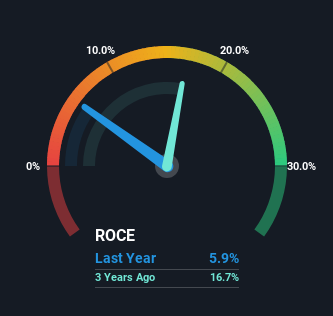- United Kingdom
- /
- Consumer Services
- /
- AIM:TRB
Tribal Group (LON:TRB) May Have Issues Allocating Its Capital
What are the early trends we should look for to identify a stock that could multiply in value over the long term? Amongst other things, we'll want to see two things; firstly, a growing return on capital employed (ROCE) and secondly, an expansion in the company's amount of capital employed. If you see this, it typically means it's a company with a great business model and plenty of profitable reinvestment opportunities. In light of that, when we looked at Tribal Group (LON:TRB) and its ROCE trend, we weren't exactly thrilled.
Understanding Return On Capital Employed (ROCE)
Just to clarify if you're unsure, ROCE is a metric for evaluating how much pre-tax income (in percentage terms) a company earns on the capital invested in its business. Analysts use this formula to calculate it for Tribal Group:
Return on Capital Employed = Earnings Before Interest and Tax (EBIT) ÷ (Total Assets - Current Liabilities)
0.059 = UK£4.0m ÷ (UK£108m - UK£40m) (Based on the trailing twelve months to June 2023).
Thus, Tribal Group has an ROCE of 5.9%. In absolute terms, that's a low return but it's around the Consumer Services industry average of 7.1%.
View our latest analysis for Tribal Group

Above you can see how the current ROCE for Tribal Group compares to its prior returns on capital, but there's only so much you can tell from the past. If you're interested, you can view the analysts predictions in our free report on analyst forecasts for the company.
What The Trend Of ROCE Can Tell Us
On the surface, the trend of ROCE at Tribal Group doesn't inspire confidence. Around five years ago the returns on capital were 16%, but since then they've fallen to 5.9%. However it looks like Tribal Group might be reinvesting for long term growth because while capital employed has increased, the company's sales haven't changed much in the last 12 months. It may take some time before the company starts to see any change in earnings from these investments.
On a side note, Tribal Group has done well to pay down its current liabilities to 38% of total assets. That could partly explain why the ROCE has dropped. Effectively this means their suppliers or short-term creditors are funding less of the business, which reduces some elements of risk. Since the business is basically funding more of its operations with it's own money, you could argue this has made the business less efficient at generating ROCE.
What We Can Learn From Tribal Group's ROCE
To conclude, we've found that Tribal Group is reinvesting in the business, but returns have been falling. Since the stock has declined 36% over the last five years, investors may not be too optimistic on this trend improving either. Therefore based on the analysis done in this article, we don't think Tribal Group has the makings of a multi-bagger.
One more thing to note, we've identified 1 warning sign with Tribal Group and understanding it should be part of your investment process.
For those who like to invest in solid companies, check out this free list of companies with solid balance sheets and high returns on equity.
Valuation is complex, but we're here to simplify it.
Discover if Tribal Group might be undervalued or overvalued with our detailed analysis, featuring fair value estimates, potential risks, dividends, insider trades, and its financial condition.
Access Free AnalysisHave feedback on this article? Concerned about the content? Get in touch with us directly. Alternatively, email editorial-team (at) simplywallst.com.
This article by Simply Wall St is general in nature. We provide commentary based on historical data and analyst forecasts only using an unbiased methodology and our articles are not intended to be financial advice. It does not constitute a recommendation to buy or sell any stock, and does not take account of your objectives, or your financial situation. We aim to bring you long-term focused analysis driven by fundamental data. Note that our analysis may not factor in the latest price-sensitive company announcements or qualitative material. Simply Wall St has no position in any stocks mentioned.
About AIM:TRB
Tribal Group
Through its subsidiaries, provides software and services to education institutions worldwide.
Excellent balance sheet and good value.
Similar Companies
Market Insights
Community Narratives




